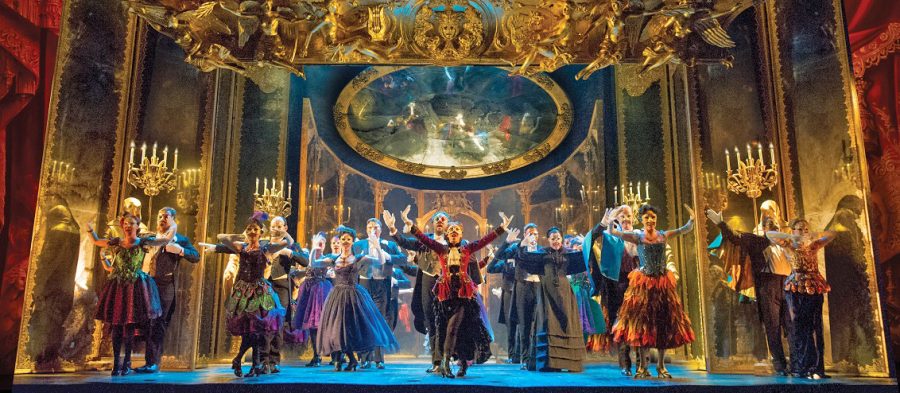
The Phantom of the Opera. Music by Andrew Lloyd Webber, lyrics by Charles Hart with additional lyrics by Richard Stilgoe. Book by Richard Stilgoe and Andrew Lloyd Webber.
The Phantom of the Opera has been running in London, New York and on tour for thirty years. It’s the longest-running show in Broadway history, and still playing. We attended the show’s 2017 national tour during a stop at Philadelphia’s Academy of Music and can report that it retains powerful impact.
The touring production is a “re-imagined” Phantom with updated staging, props and choreography. The enduring appeal is still the concept of a deformed man who loves a young woman. Almost everyone recoils when confronting disfigurement or deformity, then feels remorse about such a response. Thus we sympathize with the Phantom even though he’s a predator and a killer, and hope for the consummation of his relationship with Christine Daaé. And we are emotionally overwhelmed when she embraces him and he is unable to accept this love.
The Philadelphia engagement, through November 12, is notable because of a real-life parallel to the fictional story. Kaitlyn Davis, not even listed as an understudy, was brought in to play the role of Christine, just as the Phantom’s protegee Christine suddenly replaces another woman as prima donna at the Paris Opera. She is the best interpreter among the many Christines I’ve seen since 1989.
Davis has pure beauty in her high notes plus a seamless connectivity as she descends through mid-range to belting low notes. Her diction is unusually clear, and the diminutive lady (whose height doesn’t even come up to the Phantom’s shoulders) superbly projects youth and vulnerability with passion and moxie. A highlight is her at her father’s grave pleading Andrew Lloyd Webber’s ballad, “Wishing You Were Somehow Here Again.”
Derrick Davis (no relation) displays a strong voice as the Phantom. Although I’ve seen others who are more scary and/or seductive, when he takes his soprano by gondola to his secret lair and sings “The Music of the Night” his soft closing note is eerie. He rises to dramatic heights in his pitiful final scene. Jordan Craig plays an earnest Raoul, who wants to marry Christine. Poor Raoul; he’s a rich, handsome guy who sings sweetly, but we want Christine to end up with his rival. Trista Moldovan is a striking and funny Carlotta, and all the other supporting characters are excellent.
Producer Cameron Mackintosh hired director Laurence Connor and designer Paul Brown two years ago to restage Phantom of the Opera, which continues on Broadway and in London in its original Hal Prince version. New choreography is by Scott Ambler while new costumes honor the original designs of the late Maria Bjornson. Connor is the British director of the new production of Les Miserables which eliminated its annoying turntable. Phantom did not require such a re-do but the touring production does make some interesting dramatic points.
The most noticeable difference is the staging of “Masquerade” at the top of act 2. On Broadway it takes place on a giant staircase; here it’s on flat ground with a large reflecting mirror overhead. The underground grotto is not as impressive. On the other hand, “The Point of No Return” is a sultry and passionate duet entwining the Phantom and Christine, and the “Prima Donna” number here is very funny. The famed chandelier remains a center of attention as it lights up, drops towards the audience and explodes. I regret a change of the final image, which I won’t disclose here.
Jamie Johns leads a 14-person pit orchestra that includes three keyboards which produce rich sonorities, including those of an organ. Despite being small in numbers, this orchestra does justice to the lush Webber score. Mick Potter deserves special praise for outstanding sound design that surrounds us.
This production moves on to Waterbury Connecticut, Memphis and Minneapolis.